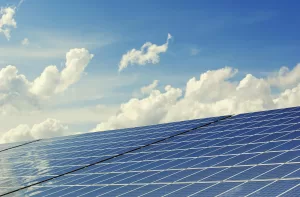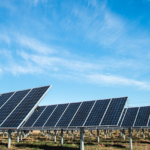In 2023, Europe experienced multiple severe hailstorms. According to the European Severe Weather Database (ESSL), there were a total of 9,627 reports of large hail (diameter ≥ 2 cm), an increase of 2,791 reports compared to 2022. Among these, 1,931 reports were classified as very large hail (diameter ≥ 5 cm), and 92 reports were classified as giant hail (diameter ≥ 10 cm). These statistics mark 2023 as the third consecutive year of significant hailstorm activity in Europe. The particularly severe hailstorm season lasted from May 20 to July 10, with very large hail observed over a span of 42 days. France, Italy, and Germany reported the highest numbers of hail incidents, with France recording 2,461 reports, Italy 993, and Germany 583.

As extreme weather events increase and the storm season lengthens, one of the most common questions we hear from potential customers is whether hail can damage the solar panels installed on their roofs.
The good news is that while modern commercial solar panels are not indestructible, they are remarkably robust and can withstand most hail impacts. Want to learn more? Read on.
How large a hailstorm can damage Solar PV Panels
The extent of hail damage to solar panels primarily depends on the following factors:
- Hail Diameter:
Typically, hail larger than 1.75 inches (approximately 44 mm) in diameter can cause significant damage to solar panels. Larger hailstones exert greater impact force upon striking, making them more likely to crack or break the panels. - Hail Velocity:
The speed at which hail falls is also a crucial factor. High-speed hail (usually exceeding 80 mph or about 128 km/h) can increase the destructive potential, potentially leading to panel damage. - Panel Durability:
The manufacturing quality and design of the solar panels affect their resistance to hail. Panels that meet International Electrotechnical Commission (IEC) standards are typically tested to withstand hailstones up to 1.25 cm (about 0.5 inches) to 1.75 cm (about 0.75 inches) in diameter, falling at speeds up to 140 km/h (approximately 87 mph). High-quality panels generally perform well against small to medium-sized hail.

In summary, while most solar panels can withstand small to medium-sized hail impacts, they may incur damage when exposed to large hail (particularly those exceeding 1.75 inches in diameter or high-velocity hail). Therefore, it is essential to consider these factors when designing and installing solar energy systems.
How to Protect Solar Panels From Hail Storms
1. Buy Panels Rated UL 61730, UIC 61730, or IP68
To safeguard solar panels against hailstorms, purchase resilient models. Panels rated UL 61730 are tested to withstand hail strikes of 1 to 3 inches traveling at speeds up to 88.3 mph (142 kph). Additionally, ensure panels have an IP68 rating, indicating they are waterproof and dustproof. This protection helps prevent secondary damage from leaks due to cracked panels. Most modern panels meet these standards, significantly reducing the risk of hail damage. However, regions like Texas, Oklahoma, and Nebraska experience severe storms, making additional precautions essential.
2. Use a Solar Panel Protection Cover
If a hailstorm is expected or when parking your RV for an extended period, consider using a protective cover for your solar panels.
A solar panel cover can shield against hail, dust, bird droppings, and other debris. Different options include:
- RV Solar Panel Protective Covers: Hardcovers provide maximum protection against impacts but block light, preventing power generation while in place. Softer covers offer less protection but are easier to handle and can suffice during most hailstorms.
- Hail Covers: Designed to protect against small to medium hailstones, these padded covers absorb impact. However, they may reduce sunlight and should be removed promptly after the storm.
- Tarps: A quick and cost-effective solution, plastic or canvas tarps can offer some hail protection.
- RV Covers: These provide cushioning against hail impacts on solar panels and other RV components. However, they may not effectively shield against large hailstones and could tear upon impact.
3. Spray a Methacrylate Layer
Methacrylate is an affordable spray-on monomer that protects your solar panels while still allowing them to receive and convert sunlight. However, it’s important to apply the right amount for adequate protection. Avoid spraying methacrylate on metal parts of the panel, as it can cause damage and reduce electrical efficiency.
Methacrylate is a cost-effective solution for protecting solar panels, but overapplication can hinder their ability to collect and store solar energy. Follow the instructions closely, and consider testing a small area first to ensure the correct application.
4. Optimize System Design and Installation
- Strategic Tilt Angles:The angle at which the PV array is installed can significantly minimize direct hail impact. Steeper angles reduce the area exposed to hail, thereby lowering potential damage.
- Reinforced Mounting Systems:Using reinforced racks and mounting systems enhances the structural integrity of the PV array during hailstorms, reducing the risk of panel displacement or breakage.
5. Obtain Comprehensive Insurance Coverage
Invest in comprehensive insurance for your solar energy system to cover damage from hail and other disasters. Ensure it includes protection for both equipment and loss of income during downtime. Regularly review your policy to keep pace with your system’s increasing value, providing peace of mind against unexpected weather events.
Conclusion
In most hailstorms, solar panels are generally safe and can withstand significant impacts. Only storms with extremely large hail are likely to cause damage. Nevertheless, it’s wise to take preventive measures against potential damage. Covering, coating, or tilting the array away from incoming hail can help protect your PV panels from severe impacts.
Prevention starts with high-quality components. Maysun Solar offers high-efficiency solar panels and power kits designed to endure extreme weather conditions. Whether you’re looking for portable, rigid, or flexible solar panels, EcoFlow has durable and efficient products for your home.

Since 2008, Maysun Solar has been dedicated to producing high-quality photovoltaic modules that contribute to combating climate change. Our advanced technology in IBC, HJT, TOPCon, and balcony solar panels ensures exceptional performance and reliability, capable of withstanding harsh weather conditions for long-term operation. We have established offices and warehouses in multiple countries and built lasting partnerships with top installers to provide comprehensive support. For the latest quotes or any inquiries related to photovoltaics, feel free to reach out to us—we’re here to help!
Reference:
Pucik, T. (2024, January 23). Hailstorms of 2023 | European Severe Storms Laboratory. https://www.essl.org/cms/hailstorms-of-2023/
Z, F. (2024b, August 14). 7 Easy and effective ways to protect RV solar panels from hail! BougeRV Australia. https://au.bougerv.com/blogs/article/how-to-protect-rv-solar-panels-from-hail
Ecoflow. (2023, August 31). 8 Ways To Protect Your Solar Panels from Hail Storm Damage. EcoFlow US Blog. https://blog.ecoflow.com/us/how-to-protect-solar-panels-from-hail-storm-damage/
You may also like:

Which solar modules perform better under high summer temperatures?
Can high summer temperatures reduce the power generation efficiency of solar modules? This article compares the performance of HJT, TOPCon, and IBC modules under high temperatures to help you make informed choices and optimize your return on investment.

Structural Risks and Component Adaptation Strategies for Commercial PV Deployment under Extreme Weather Conditions
A comprehensive analysis of the structural risks and component configuration strategies for commercial and industrial PV systems under extreme weather conditions, helping businesses enhance system stability and long-term energy yield.

How Can Photovoltaics Help Businesses Cut Peak Electricity Costs During Summer Price Spikes?
How Can Businesses Use Photovoltaic Systems to Address Summer Electricity Price Peaks? This article provides cost-saving calculations, suitability conditions, and technical selection recommendations.

How to Detect Hotspots and PID Effects in PV Modules to Prevent Long-Term Losses?
How to identify and respond to hotspots and PID effects in PV modules? This article focuses on the European market, combining detection technologies, real-world cases, and protection strategies to provide developers and investors with reliable loss warnings and yield protection solutions.

How to Choose the Most Suitable Solar Panels for Commercial and Industrial Use in 2025
How can commercial and industrial projects choose the right solar panels in 2025?
This article provides a systematic comparison of mainstream panel types such as TOPCon, HJT, and IBC, analyzing their advantages, disadvantages, and suitable applications. It aims to help businesses make accurate selections based on specific project conditions, thereby improving long-term energy output and return on investment.

After the Iberian Blackout How Can Enterprises Reshape Their Energy Security Systems
The 2025 Iberian blackout drew widespread attention across Europe. This article analyzes grid vulnerability, enterprise energy risks, and the deployment path of “solar + storage + EMS” systems to help businesses build a controllable and secure energy structure.



-150x150.png)